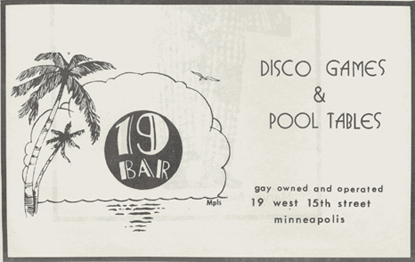Difference between revisions of "19 Bar"
| Line 30: | Line 30: | ||
---- | ---- | ||
<small>(1)</small> Minneapolis City Directories, 1950-1960. Hennepin County Public Library: Central Library, 4th floor reference stacks. | <small>(1)</small> Minneapolis City Directories, 1950-1960. Hennepin County Public Library: Central Library, 4th floor reference stacks. | ||
| + | |||
This page is still under construction. -SVC | This page is still under construction. -SVC | ||
| + | |||
| + | Part of [[Minneapolis/St. Paul, MN: 100 Queer Places in Minnesota History, (1860-1969), (1969-2010)]] | ||
Revision as of 13:10, 26 February 2010
The 19 Bar
19 West 15th Street, Minneapolis, MN
Built on 15th Street West between Nicollet and Lasalle—in the shadows of two immense hotels: the Donald and the Buckingham—19 West 15th Street was once prime real estate in Minneapolis' burgeoning apartment district. The building was steps from the Nicollet Avenue trolley line, the Minneapolis Auditorium, and Loring Park. It once served a prewar neighborhood of young professionals, visiting businessmen, and newlywed families.
Non-normative people replaced young nuclear families in the area following the Depression and WWII. Perhaps responding to the newly colorful clientele of the area, Harry S. Kirshbaum sold his “Nineteen Bar” to Evrett L. Stoltz—an unmarried resident of Park Terrace Apartments(1)—in 1956, beginning the 19 Bar’s history as the oldest LGBT-owned bar in the Twin Cities.
An advertisement for the 19 in the Twin Cities Pride Guide, 1979,
Image courtesy of the Jean-Nickolaus Tretter Collection in GLBT Studies
The 19 quickly became the epicenter of a vibrant “Gay Ghetto” whose population migrated from the demolished Gateway District and from an emerging Gay and Lesbian separatist movement. Inhabitants of the “Ghetto” likely met their “trade” in the bar and would retire to another location to engage in sexual activity. Because this activity often took place in Loring Park, parked cars, and other public locations, the City of Minneapolis aggressively attempted to close the 19 Bar and demolish its surrounds in the latter half of the 20th century. In part, local officials wished to remove unsavory populations using urban renewal in an attempt to recapture the attention of traditional families.
While Municipal efforts successfully forced much of the queer population out of the area, the 19 Bar survives to this day. Its significance has diminished alongside other gay bars with the advent of LGBT social organizations, HIV/AIDS, and acceptance of queer people among the heterosexual majority, yet the bar retains essential elements of its past: a diverse clientele, simplicity, and a good urban location.
(1) Minneapolis City Directories, 1950-1960. Hennepin County Public Library: Central Library, 4th floor reference stacks.
This page is still under construction. -SVC
Part of Minneapolis/St. Paul, MN: 100 Queer Places in Minnesota History, (1860-1969), (1969-2010)
